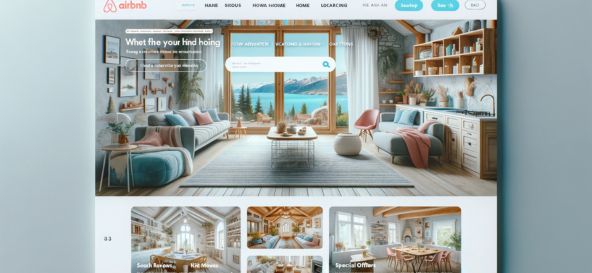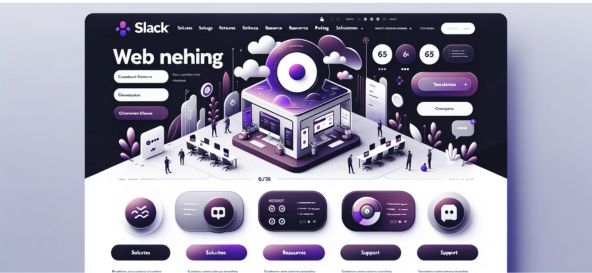Exploring Website Design Concepts That Convert
In today’s digital age, a website is often the first point of contact between your business and potential clients. A website that is well-designed can help you attract and retain customers while a poorly designed website can drive them away. It’s crucial to understand the importance of website design and explore concepts that can help you create a visually appealing and user-friendly website. In this article, we will delve into website design ideas, inspiration, trends, and tips that are proven to increase conversions.
Key Takeaways:
- Website design concepts impact user experience and conversion rates
- Design elements such as layout, color scheme, and typography contribute to a website’s aesthetics
- Keeping up with website design trends can attract and retain visitors
- Effective website design incorporates user experience principles and optimization for mobile devices
- Call-to-actions (CTAs) play a vital role in driving conversions through strategic placement and compelling messaging
Understanding the Importance of Website Design
When it comes to website design, it’s important to understand that it’s not just about aesthetics. While a visually appealing website can certainly leave a lasting impression, there are other crucial factors to consider as well.
Firstly, an effective website design should be user-friendly and intuitive. This means that visitors should be able to navigate your site easily, find what they’re looking for quickly, and enjoy a seamless user experience. If your website design is confusing, cluttered, or difficult to navigate, visitors are likely to become frustrated and leave.
Additionally, website design can significantly impact your website’s search engine optimization (SEO). A well-designed website can improve your search engine rankings, making it easier for potential customers to find your site.
Overall, a well-designed website can have a significant impact on your business’s success. By taking the time to develop a website design concept that is visually appealing, user-friendly, and optimized for search engines, you can create a website that attracts and retains visitors, ultimately increasing conversions and revenue.
Embracing Innovative Website Design Ideas
If you want to make your website stand out from the competition, it’s crucial to embrace innovative website design ideas. By exploring unique and creative concepts, you can make your website visually engaging and memorable to visitors.
Website Design Concepts to Consider
- Micro-Animations: Adding small animations to your website creates a fun and interactive experience for users.
- Dark Mode: Offering a dark mode option on your website can reduce eye strain and improve user experience in low-light conditions.
- Custom Illustrations: Using custom illustrations instead of generic stock photos can add personality and uniqueness to your website.
- Asymmetry: Experimenting with asymmetrical layouts can create a sense of visual interest and dynamism on your website.
Implementing Website Design Ideas
When implementing website design ideas, it’s important to consider your brand identity, target audience, and overall website goals. You can gather inspiration from other successful websites, but make sure to put your own spin on the ideas to differentiate yourself and stand out.
“Design is not just what it looks like and feels like. Design is how it works.” – Steve Jobs
Ultimately, the most innovative website design ideas are the ones that effectively enhance user experience and drive conversions.
Drawing Inspiration from Successful Website Designs

When it comes to website design, drawing inspiration from successful websites is a smart strategy. By analyzing what works for other sites, you can apply those design concepts to your own site and potentially increase conversions.
One website design concept to consider is the use of whitespace. Whitespace, or negative space, refers to the area around objects on a web page that is left empty. Including sufficient whitespace can create a clean and organized design, making it easier for visitors to navigate your site. Utilizing whitespace can also draw attention to important content or calls-to-action.
Another effective design element is the use of high-quality images. Images can evoke emotion and visually communicate your brand message. Consider using high-resolution images that align with your brand’s style and values. Don’t forget to optimize the image size to ensure fast loading times and prevent slow page speeds.
“Good design is obvious. Great design is transparent.”
– Joe Sparano
When it comes to website design inspiration, don’t limit yourself to websites in your industry. Look for designs that catch your eye and analyze what makes them compelling. Pay attention to color schemes, typography, and layout. Consider how those design elements can be applied to your own site while still maintaining your brand identity.
Remember, website design is not just about aesthetics, it’s also about user experience. Focus on creating a user-friendly design that is easy to navigate and guides visitors towards your desired actions. By incorporating successful design concepts from other websites and tailoring them to your own brand, you can create a visually engaging and effective website.
Keeping Up with Website Design Trends
Design trends are always evolving, and it’s essential to stay updated to keep your website fresh and engaging. Incorporating current design elements can enhance your site’s aesthetics and functionality, attracting and retaining visitors and driving conversions. Here are some of the latest website design trends:
Minimalism
The “less is more” concept remains on top as a popular design trend. Embrace white space, clean typography, and simple navigation to improve the user experience. With minimalism, you can create a sleek, modern look that focuses on your content and highlights what’s essential.
Dark Mode
Dark mode has gained popularity recently, with users gravitating towards darker color schemes that reduce eye strain and save device battery. Experiment with using black or dark shades of gray as a background color to give your site a sleek, sophisticated look.
Personalization
Website personalization is becoming increasingly important as visitors expect a tailored experience. Use dynamic content that changes based on user behavior, location, or other factors to make your site feel more customized. Personalization can make your visitors feel valued and increase engagement, leading to higher conversions.
3D Elements
Three-dimensional (3D) design elements can make your website stand out and create a unique visual experience. Incorporate 3D shapes, textures, and animation to add depth and dimension to your site.
Bright Colors
Bright and bold colors can create an eye-catching visual experience that captures visitors’ attention. Be mindful of color contrasts and ensure that your color choices align with your brand identity.
Mobile Optimization
Mobile devices are becoming increasingly popular for browsing the internet, and mobile optimization is critical to ensure your site looks and functions well on smartphones and tablets. Use responsive design that adapts to different screen sizes and implement features like “tap to call” or location-based services that enhance the mobile user experience.
By keeping up with website design trends, you can ensure your site looks modern and engaging, maximizing its potential for conversions. Experiment with different trends and find what works best for your brand and audience.
Essential Tips for Effective Website Design
Designing a website that encourages conversions can be challenging. In this section, you’ll learn helpful tips on how to create an effective website design that engages visitors and drives conversions.
1. Embrace responsive design
Responsive design means that your website should look good and function well on all devices, including desktops, laptops, tablets, and smartphones. Ensure that your site adjusts to different screen sizes and resolutions smoothly, providing a seamless experience to users.
2. Keep navigation intuitive and straightforward
Navigation is a crucial aspect of website design. It should be easy for users to find what they’re looking for quickly. Keep navigation menus simple, clear, and easy to follow. Avoid using too many dropdown menus and submenus, which can be overwhelming.
3. Use high-quality visuals
Visual content plays a vital role in website design. Use high-quality images, videos, and graphics that are relevant to your website’s content. Make sure they’re optimized for the web to ensure fast loading times, as slow-loading visuals can be frustrating to users.
4. Ensure clear calls-to-action (CTAs)
CTAs are essential in encouraging visitors to take desired actions, such as making a purchase or signing up for a newsletter. Make sure your CTAs are clear, compelling, and prominently displayed on your website.
5. Make your website easy to scan
Most website visitors don’t read every word on a page. They scan the content quickly to find the information they need. Use headings, subheadings, bullet points, and short paragraphs to make your content easy to scan.
By implementing these essential tips, you can create an effective website design that engages visitors and encourages conversions.
Showcasing Outstanding Website Design Examples
Looking for some inspiration to create a visually engaging and user-friendly website design? Let’s take a look at some real-world examples of websites that have seamlessly integrated design concepts resulting in a high conversion rate.
1. Adobe

- Clear and consistent design language across the website
- Visually engaging icons, images, and color palette
- Intuitive navigation and easy-to-use interface
2. Airbnb

- Striking visuals and use of white space
- Clean and simple navigation and interface
- Effective use of colors, images, and call-to-action (CTA) buttons
3. Slack

- Consistent, recognizable design and messaging
- Cohesive use of colors and typography
- Clean and simple navigation with a focus on user experience (UX)
These examples showcase the importance of having a well-designed website that seamlessly integrates design concepts and best practices. By using creative and visually engaging designs, intuitive navigation, and effective CTAs, these websites have been able to optimize their conversion rates.
Incorporating User-Focused Design Concepts
When creating a website, it’s essential to keep your users in mind since their experience can have a significant impact on your conversion rates. By incorporating user-focused design concepts, you can create a site that is engaging and user-friendly.
Understanding User Experience (UX) Principles
User experience (UX) is the practice of creating a website that is easy to use, accessible, and enjoyable for its intended users. This includes:
- Creating a clear navigation structure
- Ensuring fast loading speed
- Providing high-quality content
- Making the design visually appealing and accessible for all users, including those with disabilities
Adhering to these principles can result in a website that is easy to use, intuitive, and enjoyable for users, improving their experience on the site and encouraging them to take the desired actions.
Optimizing Site Usability
Optimizing the usability of your site requires thoughtful consideration of website design elements and how they impact user experience. Key elements to consider include:
- Accessibility: Ensure that your site is accessible to all users, including those with disabilities. Consider using tools such as image alt text, text transcripts, and descriptive links to make your site more accessible.
- Website Navigation: Creating a clear and concise navigation structure can help users find the information they need quickly and efficiently. Use intuitive navigation labels and organize content in an easy-to-follow manner.
- Responsive Design: With the advent of mobile devices, responsive design has become more important than ever. Ensure your site is mobile-friendly and adapts to different screen sizes and resolutions.
Building Trust with Users
Building trust with your users is critical to encouraging conversions. Elements that can help build trust include:
- Strong Branding: Your branding should be consistent, professional, and engaging. Use visually appealing graphics and typography to create a memorable and recognizable brand.
- Reviews and Testimonials: Including customer reviews and testimonials can reassure potential customers that your products or services are worthy of their investment.
- Contact Information: Make it easy for users to contact you with any questions or concerns they may have. Include clear contact information, such as phone numbers and email addresses.
The Impact of User-Focused Design Concepts on Conversions
| User-Focused Design Concepts | Impact on Conversions |
|---|---|
| Clear Navigation | Can increase conversions by 30% |
| Mobile-Friendly Design | Can increase conversions by 10% |
| Accessibility Features | Can increase conversions by 8% |
| Customer Reviews/Testimonials | Can increase conversions by 7% |
| Strong Branding | Can increase conversions by 5% |
By incorporating user-focused design concepts into your website design, you can increase the chances of visitors becoming customers. Elements such as clear navigation, mobile-friendly design, accessibility, and building trust with your audience can significantly impact your conversion rates.
Enhancing Your Website’s Speed and Performance

A fast-loading website is essential to ensuring a seamless user experience and improving conversion rates. A slow website can frustrate users, causing them to abandon your site and seek out your competitors instead. Slow loading times can also negatively impact your site’s search engine rankings, making it harder for potential customers to find you.
Optimizing Images
One of the main culprits of slow-loading websites is large, unoptimized images. To improve your site’s speed and performance, make sure to optimize your images by compressing them and reducing their file size. This can significantly reduce the time it takes for your site to load, without sacrificing image quality.
Minimizing HTTP Requests
Another way to improve your site’s speed and performance is by minimizing the number of HTTP requests it makes. This means reducing the number of files that need to be loaded when someone visits your site. You can achieve this by combining multiple CSS and JavaScript files into a single file, reducing the size of your HTML files, and using browser caching to store frequently used files locally.
Choosing a Reliable Web Host
The quality of your web host can also have a significant impact on your site’s speed and performance. When choosing a web host, look for one that provides reliable and fast servers, as well as a content delivery network (CDN) to help distribute your website’s content across different servers and increase loading speed.
Using a Content Delivery Network (CDN)
As mentioned above, using a CDN can help increase your site’s loading speed by distributing your website’s content across multiple servers. This reduces the distance between the server and the user, resulting in faster loading times. Some popular CDNs include Cloudflare, MaxCDN, and Amazon CloudFront.
Reducing Plug-Ins
While plug-ins can provide added functionality to your website, they can also slow it down. To improve your site’s speed and performance, consider reducing the number of plug-ins you use and uninstalling any that aren’t necessary.
Optimizing Website Design for Mobile Devices
As mobile device usage continues to rise, it’s vital to ensure that your website is mobile-friendly. With over 52% of website traffic coming from mobile devices in 2018, it’s clear that mobile optimization is a must for any website owner.
Creating a mobile-responsive design means optimizing your website’s layout, images, and content to fit on smaller screens while maintaining functionality and efficient load times. This also includes using a responsive design framework that allows your website to adapt to any screen size.
Implementing this concept can be a complex process, but there are some tips you can follow to help optimize your website for mobile:
- Ensure that your website is easy to navigate on a mobile device with clear calls-to-action (CTAs) that are clickable and easy to access
- Make sure that your content is easy to read on smaller screens by using a legible font size and avoiding large blocks of text
- Optimize images for mobile with smaller file sizes and load times, without sacrificing image quality
- Consider using a mobile-first design approach that prioritizes mobile users and their needs
- Test your website on different mobile devices and platforms to ensure that it functions correctly and looks great on all of them.
In conclusion, mobile optimization is essential for any business or website looking to succeed online. By implementing mobile-responsive design concepts and techniques, you can provide a seamless user experience on any device and maximize your website’s potential.
Implementing Effective Call-to-Actions and Conversions
When it comes to website design, call-to-actions (CTAs) are a critical aspect of determining your conversion rates. CTAs guide users towards the desired action, whether it’s making a purchase, filling out a form, or subscribing to a newsletter. Here are some best practices for creating effective CTAs:
- Be clear and concise: Your CTA should clearly communicate what action you want users to take. Use brief, action-oriented language like “Order Now” or “Sign Up Today.”
- Make it visually prominent: Your CTA should be visually appealing and stand out on the page so users can easily find it. Use contrasting colors or bold text to make it pop.
- Place it strategically: Your CTA should be placed in a prominent location on the page, such as at the end of a blog post, or in the header or footer of your website.
- Offer an incentive: To entice users to complete the desired action, consider offering a discount or free trial. This can increase the likelihood of a conversion.
By incorporating these best practices into your website design, you can create CTAs that effectively guide users towards the desired action and ultimately increase your conversion rates.
Conclusion
Now that you have explored various website design concepts, you have a solid foundation for creating a visually appealing and user-friendly website that converts. Remember, design matters and can significantly impact your site’s user experience.
By incorporating innovative website design ideas, drawing inspiration from successful designs, and staying updated with the latest trends, you can ensure your site stays ahead of the competition.
Keep in mind the essential tips for effective website design, prioritize user-focused design concepts, and optimize your site’s performance for both desktop and mobile devices.
Finally, ensure your site has clear and compelling call-to-actions that guide users towards desired actions. By implementing these strategies, you can create a website that engages visitors and drives conversions, ultimately leading to business success.
FAQ
What is a website design concept?
A website design concept refers to the overall visual and aesthetic direction of a website. It involves the choice of colors, typography, layout, and other design elements that create a cohesive and appealing look for the site.
Where can I find website design ideas?
There are various sources for website design ideas. You can browse design galleries, visit competitor websites, explore design blogs and portfolios, or seek inspiration from other industries and art forms.
How can I find website design inspiration?
You can find website design inspiration by researching and analyzing well-designed websites in your industry or other relevant industries. Pay attention to layout, color schemes, typography, and overall user experience to gather ideas for your own website.
What are some current website design trends?
Some current website design trends include minimalism, bold typography, vibrant colors, microinteractions, dark mode, 3D elements, and asymmetrical layouts. However, it’s important to balance following trends with creating a unique and user-friendly design.
Can you provide some tips for effective website design?
Certainly! Some essential tips for effective website design include prioritizing user experience, using consistent branding elements, optimizing for mobile devices, ensuring fast loading times, incorporating intuitive navigation, and creating compelling visual content.
Are there any examples of outstanding website designs?
Yes, there are numerous examples of outstanding website designs. Some well-known examples include Apple, Airbnb, Nike, and Trello. By studying these examples, you can gain insights into how successful businesses have implemented effective design concepts.
What is user-focused design in website design?
User-focused design involves creating a website that prioritizes the needs and preferences of the target audience. It aims to provide a seamless and enjoyable browsing experience by focusing on usability, accessibility, and intuitive interface design.
How can I optimize my website design for mobile devices?
To optimize your website design for mobile devices, you can use responsive design techniques. This ensures that your website automatically adjusts its layout and elements based on the screen size of the user’s device, providing a consistent and user-friendly experience.
What is the role of call-to-actions in website design?
Call-to-actions (CTAs) play a crucial role in website design as they direct users to take desired actions, such as making a purchase, signing up for a newsletter, or contacting the business. Effective CTAs are strategically placed, visually appealing, and use compelling language to encourage conversions.
How can I enhance my website’s speed and performance?
You can enhance your website’s speed and performance by optimizing images and other media files, minimizing plugins and scripts, enabling caching, using a content delivery network (CDN), and choosing a reliable hosting provider. Regularly testing and optimizing your site’s performance is also important.
Why is website design important?
Website design is important because it directly impacts user experience, credibility, and conversion rates. A well-designed website enhances the overall perception of a brand, establishes trust with visitors, and provides an intuitive and enjoyable browsing experience.
How do I incorporate website design concepts that convert?
Incorporating website design concepts that convert involves understanding your target audience, conducting user research, creating clear and intuitive navigation, using compelling visuals, optimizing for mobile responsiveness, and constantly testing and analyzing the effectiveness of your design elements.



